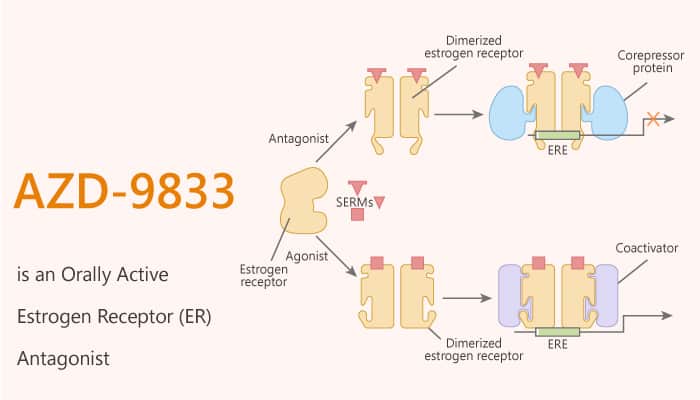Estrogens participate in numerous physiological processes such as cell growth, reproduction, and differentiation. In females, the ovaries are the major site of estrogen synthesis producing the predominant estrogen 17b-estradiol (E2). In addition to effects by E2 on normal physiology, estrogens also play an important role in several pathological processes including cancer, inflammation, and other related diseases. ER includes two subtypes, ERα and ERβ.
ERα mainly expresses in reproductive tissues (uterus, ovary), breast, kidney, bone, white adipose tissue, and liver, while ERβ expresses in the ovary, central nervous system (CNS), lung, male reproductive organs, prostate, colon, kidney, and the immune system. Additionally, during the past years, ER has been a Potential Target for Estrogen Receptor-Positive Breast Cancer. There have been large numbers of ER inhibitors that have been applied in human beings, such as Tamoxifen. Today, I’d like to introduce a novel ER antagonist AZD-9833. The compound is still in preclinical studies.

In vivo, the scientists used a human ESR1 mutant breast cancer patient-derived xenograft with CTC174 cells in the female NSG mice model. They divided the mice into 6 groups, one for control, and the other 5 groups were orally administrated AZD-9833 with different doses, including 0.8 mg/kg, 3 mg/kg, 10 mg/kg, 20 mg/kg, and 40 mg/kg.
As a result, AZD-9833 (oral administration; 0.2-50 mg/kg; 20 days) exhibits anti-tumour efficacy as a dose-dependent manner in human parental MCF7 mice xenograft. Moreover, AZD-9833 (oral administration; 0.8-40 mg/kg; 30 days) decreases tumor growth as a dose-dependent manner. It gives almost complete tumor growth inhibition at the doses >10 mg/kg in mice.
To conclude, AZD-9833 is a potent and orally active estrogen receptor (ER) antagonist. AZD-9833 has the potential for the study of ER+ HER2-advanced breast cancer.
Bernard Christophe Barlaam, et al. Chemical compounds. Patent US20180111931.